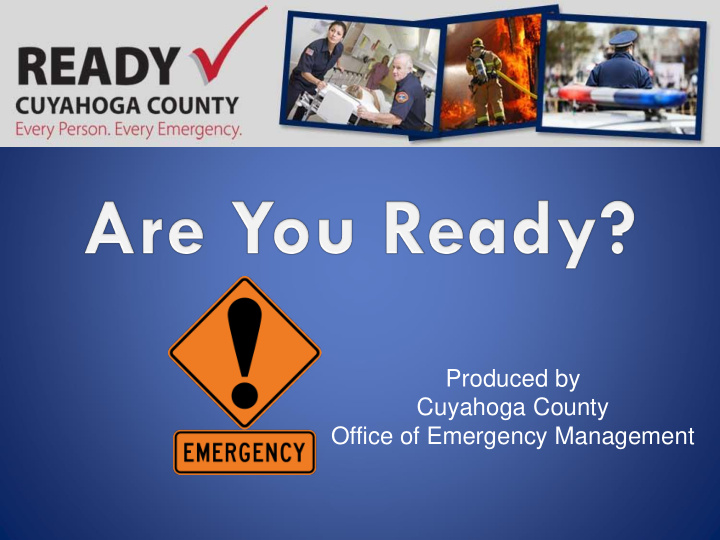



Produced by Cuyahoga County Office of Emergency Management
Mission Statement: The Cuyahoga County Office of Emergency Management is responsible for activities relating to emergency planning, preparedness, response, and mitigation, as well as assisting and coordinating emergency management-related activities with local governments and emergency response agencies.
Operations Training Outreach Local Emergency Planning Planning Exercises Committee
Why be prepared? • Disasters disrupt hundreds of thousands of lives every year. Each disaster has lasting effects, both to people and property. • If a disaster occurs in your community, local government and disaster relief organizations will try to help you, but you need to be ready as well. Local responders may not be able to reach you immediately, or they may need to focus their efforts elsewhere. • You should know how to respond to severe weather or any disaster that could occur in your area – hurricanes, earthquakes, extreme cold, flooding or terrorism. • You should also be ready to be self-sufficient for at least three days. This may mean providing for your own shelter, first aid, food, water, and sanitation.
Cuyahoga County Top Emergencies • As an Appendix to the Cuyahoga County Mitigation Plan, the Threat and Hazard Identification and Risk Assessment (THIRA) Annex enhances Cuyahoga County’s preparedness by providing a realistic appraisal of the County’s risk from Natural, Technological, and Human-caused hazards. • The THIRA serves as the basis for planning and implementing measures to reduce risks and impacts from disasters in Cuyahoga County. Emergency Management professionals use this document to guide the decision- making process when, setting priorities, allocating resources, and taking actions.
Cuyahoga County Top Emergencies • Severe Thunderstorm • Active Shooter • Utilities Disruption • Mass Transportation Incident • Flooding • Building/Structure Collapse • HAZMAT Spill/Release • Civil Disturbance • IT/Communication Disruption • Terrorism, CBRN • Severe Winter Weather • Nuclear Power Incident • Tornado • Temperature Extremes • Infectious Diseases
9/11 Terror Attack New York, New York – September 2001
Toledo, Ohio – June 2010
Findlay, Ohio – August 2007
Before, during and after: • Learn about likely threats and how to respond • Know your neighborhood – shelters, routes, etc. • Know how to get credible information • Have plans for places you spend time
Be Informed • Ready Notify – Cuyahoga County alert system • Weather Radio • Local News Stations – Apps for phones if power is out • 311 – Great resource for information without tying up an emergency line if you are dealing with a non life-threatening matter.
• Actively seek information from your – Fire Department – EMS Agency – Police Department • DHS FEMA Preparedness pamphlets • Join your local volunteer agency
Develop a Family Communication Plan • Consider a plan where each family member calls, or e-mails, the same friend or relative in the event of an emergency Create a Personal Support Network • If you anticipate needing assistance during a disaster, make a list of family, friends and others who will be part of your plan. • Make sure that someone in your personal support network has an extra key to your home and know where you keep emergency supplies
Consider your pets • Plan in advance for shelter alternatives that will work for both of you and your pets • If you are going to a public shelter, it is important to understand that only service animals may be allowed inside. Deciding to Stay or Go • Shelter-in-place – There could be times when you will need to stay put and create a barrier between yourself and potentially contaminated air outside Evacuation – Plan how you can get away and • anticipate where you will go. Choose several destinations in different directions so you have options in an emergency
Or two or three: • Home, car, work and/or school • 72 hours • Basic supplies • Additional items to consider
Home preparedness kit • Emergency radio • Bags / plastic sheeting / trash bags • Gloves
Home preparedness kit • Toilet paper • SOG or multipurpose tool • Duct tape • Important document holder
Home preparedness kit • Back pack • Home cell phone chargers / plug
Home preparedness kit • Food (2000 calories/day/person) • Water for family of 5 (8 gallons/day) • Back up generators
Mobile preparedness kit • Jumper cables • MREs • Fire extinguisher • Glow sticks
Mobile preparedness kit • First aid kit • Pen, Pencil and Paper • Whistle or Air Horn
Mobile preparedness kit • Flashlight / head lamp
Take an active role: • Take a class • Help a friend or neighbor • Citizen Corps or CERT
Only you know what you need: • Infants and young children • Elderly • Language barriers • Disabilities
Cleveland at a glance: • Snow, snow, snow • High winds and severe storms, flooding • Pandemic • Power Outage • Terrorism
Get Ready Now.
Being prepared now will help you later: • Get A Kit • Make A Plan • Be Informed • Get Involved
Office of Emergency Management 216-443-5700 https://ready.cuyahogacounty.us/ ema@cuyahogacounty.us
Recommend
More recommend